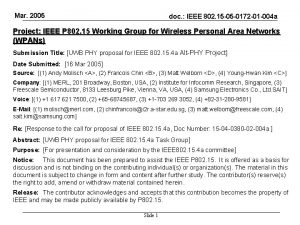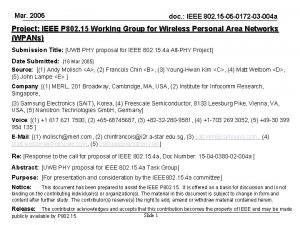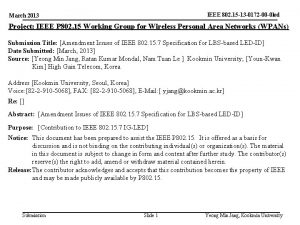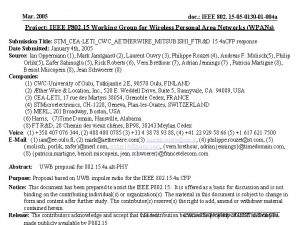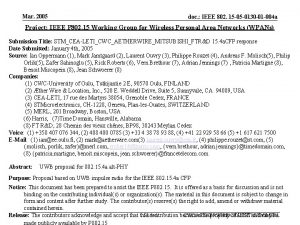Mar 2005 doc IEEE 802 15 05 0172










- Slides: 10

Mar. 2005 doc. : IEEE 802. 15 -05 -0172 -03 -004 a Project: IEEE P 802. 15 Working Group for Wireless Personal Area Networks (WPANs) Submission Title: [UWB PHY proposal for IEEE 802. 15. 4 a Alt-PHY Project] Date Submitted: [16 Mar 2005] Source: [(1) Andy Molisch <A>, (2) Francois Chin <B>, (3) Young-Hwan Kim <C>, (4) Matt Welborn <D>, (5) John Lampe <E> ] Company: [(1) MERL, 201 Broadway, Cambridge, MA, USA, (2) Institute for Infocomm Research, Singapore, (3) Samsung Electronics (SAIT), Korea, (4) Freescale Semiconductor, 8133 Leesburg Pike, Vienna, VA, USA, (5) Nanotron Technologies Gmb. H, Germany] Voice: [(1) +1 617 621 7500, (2) +65 -68745687, (3) +82 -32 -280 -9581, (4) +1 -703 269 3052, (5) +49 -30 399 954 135 ] E-Mail: [(1) molisch@merl. com, (2) chinfrancois@i 2 r. a-star. edu. sg, (3) sait. kim@samsung. com, (4) matt. welborn@freescale. com, (5) j. lampe@nanotron. com] Re: [Response to the call for proposal of IEEE 802. 15. 4 a, Doc Number: 15 -04 -0380 -02 -004 a ] Abstract: [UWB PHY proposal for IEEE 802. 15. 4 a Task Group] Purpose: [For presentation and consideration by the IEEE 802. 15. 4 a committee] Notice: This document has been prepared to assist the IEEE P 802. 15. It is offered as a basis for discussion and is not binding on the contributing individual(s) or organization(s). The material in this document is subject to change in form and content after further study. The contributor(s) reserve(s) the right to add, amend or withdraw material contained herein. Release: The contributor acknowledges and accepts that this contribution becomes the property of IEEE and may be made Slide 1 publicly available by P 802. 15.

Mar. 2005 doc. : IEEE 802. 15 -05 -0172 -03 -004 a Authors CWC: Aether. Wire: CEA-LETI: Ian Oppermann, Alberto Rabbachin Mark Jamtgaard, Patrick Houghton Laurent Ouvry, Samuel Dubouloz, Sébastien de Rivaz, Benoit Denis, Michael Pelissier, Manuel Pezzin et al. STMicroelectronics: Gian Mario Maggio, Chiara Cattaneo, Philippe Rouzet & al. MERL: Andreas F. Molisch, Philip Orlik, Zafer Sahinoglu Harris: Rick Roberts Time Domain: Vern Brethour, Adrian Jennings France Telecom R&D: Patricia Martigne, Benoit Miscopein, Jean Schwoerer Slide 2

Mar. 2005 doc. : IEEE 802. 15 -05 -0172 -03 -004 a Authors Institute for Infocomm Research: Francois Chin, Xiaoming Peng, Sam Kwok, Zhongding Lei, Kannan, Yong-Huat Chew, Chin-Choy Chai, Rahim, Manjeet, T. T. Tjhung, Hongyi Fu, Tung-Chong Wong General Atomics: Naiel Askar, Susan Lin Thales & Cellonics: Serge Hethuin, Isabelle Bucaille, Arnaud Tonnerre, Fabrice Legrand, Joe Jurianto Korea Electrotechnology Research Institute (KERI): Kwan-Ho Kim, Sungsoo Choi, Youngjin Park, Hui-Myoung Oh Soongsil University (SSU): Yoan Shin, Won Cheol Lee Kyung-Won University (KWU): Ho-In Jeon Korea Electronics Technology Institute (KETI) Sarm-Goo Cho Slide 3

Mar. 2005 doc. : IEEE 802. 15 -05 -0172 -03 -004 a Authors Create-Net & China UWB Forum: Zheng Zhou, Frank Zheng, Honggang Zhang, Xiaofei Zhou, Iacopo Carreras, Sandro Pera, Imrich Chlamtac Staccato Communications: Roberto Aiello, Torbjorn Larsson, Jason Ellis Wisair: Gadi Shor, Sorin Goldenberg National Institute of Information and Communications Technology (NICT): Huan-Bang Li, Kenichi Takizawa, Kamya Yekeh Yazdandoost, Akifumi Kasamatsu, Shigenobu Sasaki, Shinsuke Hara, Makoto Itami, Tetsushi Ikegami, Ryuji Kohno Fujitsu Limited: Toshiaki Sakane Oki Electric Industry Co. , Ltd. : Kiyohito Tokuda Hitachi, Ltd. : Akira Maeki, Ryosuke Fujiwara, Kenichi Mizugaki, Masayuki Miyazaki, Masaru Kokubo Slide 4

Mar. 2005 doc. : IEEE 802. 15 -05 -0172 -03 -004 a Authors YRP Ubiquitous Networking Laboratory: Yasuyuki Okuma, Miki Hayakawa, Shinsuke Kobayashi, Noboru Koshizuka, Ken Sakamura Freescale Semiconductor, Inc. : Matt Welborn deca. WAVE, Ltd. : Michael Mc Laughlin Wideband Access, Inc. : Saeid Safavi, Ismail Lakkis Tennessee Technological University: Robert Qiu California State University, Sacramento (CSUS): Soo-Young Chang Slide 5

Mar. 2005 doc. : IEEE 802. 15 -05 -0172 -03 -004 a Authors Samsung Electronics Co. , Ltd. (SAIT): Young-Hwan Kim, Jae-Hyon Kim, Chia-Chin Chong, Su Khiong Yong, Seong-Soo Lee Electronics and Telecommunications Research Institute (ETRI): Hyung Soo Lee, Cheol Hyo Lee Samsung Electro-Mechanics Co. , Ltd. (SEM): Jeongsuk Lee Samsung Electronics (DM): Namhyong Kim UWB-ITRC, Inha University: Kyung Sup Kwak Institute of Radio Engineering and Electronics (IRE): A. S. Dmitriev, A. I. Panas, S. O. Starkov, Yu. V. Andreyev, E. V. Efremova, L. V. Kuzmin Slide 6

Mar. 2005 doc. : IEEE 802. 15 -05 -0172 -03 -004 a Authors Hanbat University: Haksun Kim Seokyeong University: Jaesang Cha Korea Advanced Institute of Science and Technologies (KAIST): Dong Jo Park, Dan Keun Sung, Sung Yoon Jung, Chang Yong Jung Handong Global University (HGU): Joon Yong Lee Simon Fraser University: Dong In Kim, Serhat Erkucuk Nanotron Technologies Gmb. H John Lampe, Rainer Hach, and Lars Menzer Orthotron Co. , Ltd. , Hanyang University Kyung-Kuk Lee, Jong-Wha Chong Slide 7

Mar. 2005 • ABCD doc. : IEEE 802. 15 -05 -0172 -03 -004 a Points of Agreement for UWB signalling – Modulation scheme should admit multiple classes of receivers • Transmitter based on deterministic pulse structures • Should allow reception by coherent, differentially-coherent (can be TR) and noncoherent receivers • Provision for homogeneous operation when membership supports it – Ternary modulation • Specific modulation format TBD – Sub-banding: • Center of three bands is mandatory • Other two optional • Wider bandwidth (1. 5 GHz+) concentric with center band is optional • CDMA within frequency bands – Harmonic chip rate – integer relationship between center frequency and chip rate • Consider ways to avoid Japanese UNII band (shift band lower) – Integer-plus-half is also proposed, some concerns with DC balance – Maintain 3. 1 corner • Constant PRF is desired as possible – Specific band plan - TBD – Cost effective reference frequency with appropriate PPM • Specific frequency and tolerance is TBD – Potential for optional chirp mode (at best, if and where allowed) Slide 8

Mar. 2005 • • doc. : IEEE 802. 15 -05 -0172 -03 -004 a Specific Mandatory/Option Breakdown for UWB signalling As noted on previous slide Mandatory – ~500 center band • AM of 3. 1 -4. 9 is 3. 975 • GM of 3. 1 -4. 9 is 3. 877 • Center band frequency is TBD, but must be in [3. 85 to 4. 05] Optional – 2 additional 500 MHz bands for FDM – center frequencies TBD – Wideband concentric with center specified above – Sub-GHz band – Chirp of some form (could be 2. 4 GHz band – Merger E) – Chaotic waveform and SOP mechanisms for homogeneous (chaos-only) networks – Add TH as additional SOP mechanism – Add chirp specifically for UWB as SOP mechanism – Add specific optional band > 6 GHz with guaranteed >1. 5 GHz BW – Support mode for higher data rates (few to 10 Mbps) Other issues – Desire to have common packet for communications and ranging if possible – Multiple (2 -few) PRF in band Slide 9

Mar. 2005 doc. : IEEE 802. 15 -05 -0172 -03 -004 a • UWB signalling is one of the two valid modes for communication • 2. 4 GHz chirp is a valid mode for communication only • Ranging shall not be supported for 2. 4 GHz chirping, and shall be supported for UWB signalling • UWB is valid for both communications and ranging Slide 10











